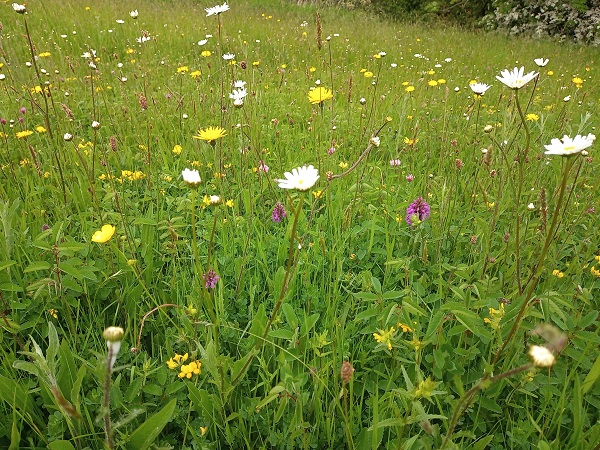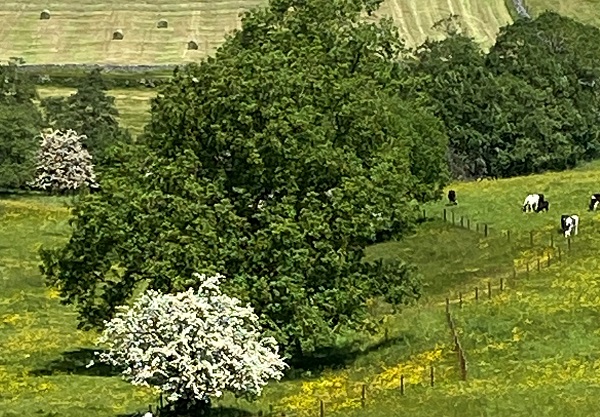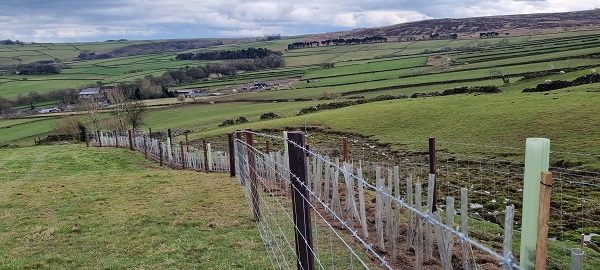Case studies - Farming in Protected Landscapes 2023

Five Wells Farm, Taddington
Building for nature conservation
An ambitious project requiring significant investment in infrastructure from FiPL and the farmer. FiPL is supporting habitat management directly through a grant for a new hay barn for the storage of late-cut, flower-rich hay from 100 hectares of grassland, including 11 hectares of SSSI. Long-term, hay can continue to be made from this large area of priority habitat.
A regionally rare limekiln – the best in the Peak District of the ‘pyekiln’ type – has been restored by volunteers from Derbyshire Drystone Walling Association, under the supervision of volunteer archaeologists.
A new permissive path takes people through the historic lead mining landscape, crossing a flower-rich hillside, hay meadows and rocky outcrops. It complements an existing permissive path allowing access to a scheduled cairn.
The farmer has restored two ponds and planted 200 trees to create a new wildlife corridor.
The interlinking projects were designed to conserve and enhance existing habitats and cultural heritage features on the farm, alongside making these accessible for people. Successive agri-environment schemes could expand this – the ambition is to transfer it to Countryside Stewardship.
- Nature - biodiversity boost from 100 hectares of grasslands cut late for flower-rich hay; 97% of hay meadows have been lost since the 1950s.
- Climate Change - 200 trees planted as a wildlife corridor will sequester carbon in the future.
- People - 20 volunteers recorded and restored a regionally rare limekiln.
- Place - new access to botanically important sites and features of cultural heritage interest.

Signings Farm, Windmill
Rare breed grazing to restore an SSSI
This farm had dropped out of Higher Level Stewardship and with the land designated SSSI, but in unfavourable condition, FiPL was critical to bring benefits back for flower-rich grasslands and breeding sites for upland waders, such as curlew.
The FiPL advisor worked with the farmer to sort out how the SSSI is managed (with Natural England) and organise revenue payments to see the farm through to returning to Countryside Stewardship.
Now, the farmer has mobile cattle handling facilities to control how the SSSI is grazed by rare breed cattle to help restore vegetation and soil condition. The regime uses no fertiliser and adds no muck to the fields.
Two dewponds have been de-silted and restored and are now habitat for great crested newts – a protected species that prefer clean ponds for breeding.
- Nature - there are 54 SSSIs in the National Park, designated to protect important wildlife sites, so it’s vital these are restored.
- Climate Change - healthy hay meadow plants are good for biodiversity and their roots hold carbon in the soil.
- Place - dewponds are a traditional feature of the White Peak landscape where surface water is scarce due to the limestone geology.

Upper Whitle Farm, Sheen
Supporting wildlife in the landscape
FiPL’s support on this smallholding has created a 200 metres long woody corridor, 10 to 15 metres wide, to establish thick hedgerows with native species that provide habitat connectivity in the wider landscape. Restoring hedgerows gives nesting and foraging opportunities for birds and mammals.
Improved livestock drinking areas are facilitating a regenerative grazing system. Hedgerows and boundaries have been restored/created along with providing water troughs and hardstanding to prevent poaching and reduce sediments running into the River Dove. This allows rotational grazing with a five-week rest period for each land parcel. It gives herbs chance to flower and seed during the summer and has benefits for livestock, such as reduced parasite burdens.
The project ties in with the Dove Catchment Partnership Vision “to make the Dove catchment a great place for people and wildlife.” It adjoins holdings with active FiPL agreements, bolstering a landscape-scale approach to nature recovery, and contributes at catchment scale to those immediately downstream.
- Nature - increased habitat diversity and new woody corridors support more wildlife.
- Climate Change - trees, hedgerows and low input, regenerative grasslands increase carbon capture.
- Place - the woodland corridor and hedgerows improves the landscape tapestry.

Hope Valley Climate Action & Hope Valley Farmers
Collaborating to plant hedges
This collaboration has brought together environmental activists, farmers, a national woodland charity and an industrial cement producer to plant hedges at eight farms in the Hope Valley.
The FiPL money has attracted match funding from the Woodland Trust, Lloyds Bank and Breedon Cement. Local voluntary environmental group – Hope Valley Climate Action – is leading the project which is co-ordinated and delivered through the local Defra-funded farmer cluster.
The project is growing with a second agreement looking to map potential for hedge enhancement and creation in the Hope Valley, develop a targeted and prioritised plan for delivery, and assess the contribution this will make to carbon sequestration and storage.
They want more farmers and landowners to see the benefits of planting more hedges and trees throughout the Peak District.
- Nature - hedgerows of diverse plant species are great habitat and act as corridors for wildlife. More than half of hedgerows have been lost since the 1950s.
- Climate Change - replacing fences with hedges locally contributes to national efforts towards Net Zero in 2050.
- People - environmental volunteers are working with eight farming families to plant hedges.
- Place - hedges help define field boundaries and add character and biodiversity to the landscape.

New Technology In Use
Eye in the sky
The Eastern Moors Partnership – National Trust and RSPB – are using a thermal drone, paid for by FiPL, to map vegetation and track deer on the Eastern Moors. It is improving how they monitor and look after the mosaic of moorland habitats. The area is managed for nature and cultural heritage conservation, as well as recreation. The drone was used during a recent wildfire to capture footage of fire behaviour to better understand how cutting and rewetting performs as part of the nature recovery role in fire mitigation.
Collaring cattle control
In a first for the Peak District, digital collars on cattle are in use at RSPB Coombes controlling where cattle wander and graze, to create a transition between woodland and grassland. Warning sounds and electrical pulses emitted by the collars tell the animals where they can and can’t go, preventing local overgrazing and keeping cattle off areas that need protecting.
Making light work of pumping water
Solar powered water pumps at Under Whitle Farm, Sheen, deliver benefits to water quality, to wetland habitats, and to livestock care by enabling water to be pumped to troughs for drinking from instead of streams.
Supporting Farm Diversification
Sales at the farm gate
At Home Farm, Hassop, a milk vending machine supports direct sales of organic milk from the holding, which is in Countryside Stewardship.
Overnight stays and crafts
At Barkerfields Farm, Bakewell, support for a pop-up campsite and shepherd’s hut, plus a pottery kiln, enables the business to interprete the Peak District landscape through clay modelling for schoolchildren and interest groups.
Barn repairs opens up opportunities for farm visits
At Higher Plainsteads Farm, Charlesworth, a grant for repairs to a barn means it can host more and better educational visits and craft courses, including visits from community and special needs groups.

